XTAPA ISLAND, & HUATULCO, MEXICO
XTAPA ISLAND, MEXICO
GETTIN' SOME Z'S We
lazed around watching the people arrive in launches and banana boats. We hated to
leave that afternoon but headed out after dinner on the boat towards
Acapulco.
ACAPULCO, MEXICO It was an easy night and a beautiful early dawn entry into
Acapulco. The surrounding hills of Acapulco were filled with sparkling lights.
Such a contrast after seeing only small villages on shore along the way. For
days we seen miles and miles of beautiful deserted beaches. We arrived early to
make our appointment for refueling at the Acapulco Yacht Club Fueling Dock.
We anchored out in the bay as the Club was full with the
sailing regatta and too noisy too boot. We were happy as our anchorage had a
good breeze and lots to watch as the regatta and tour launches went by playing
music and the sound of people laughing and having a good time. The geography of
the Bay is truly breath taking and I can understand why this bay has become the
Mexican Riviera. It is a romantic place and especially on the water away from
the hustle and bustle of the city life ashore. This was not a pleasure stop but meant for refueling and provisioning. We experienced our first Mexican supermarket. Larry loved the fresh baked bakery items and I had a hard time tearing him away from the cinnamon rolls. The produce was good and we surprisingly loaded up on Washington Apples and USA pears (all with stickers by the way) and lots of other local fruit including papaya and mangos.
HEADING TO HUATULCO, MEXICO
The next morning we headed south to Huatulco. It was
another over nighter. We arrived at 10:00 AM and navigated through their new
narrow channel that is not on any charts. The waypoint position showed the
marina ˝ mile on land! That’s because they dredged a new channel for a planned
marina hotel condominium development.
CHAHUE MARINA, HUATULCO, MEXICO The marina is brand new and surprisingly had 50-amp power
and plenty of water to wash the boat down. The docks are concrete and the place
is immaculate. There are several boaters there, just waiting to make the
crossing. It is critical to be able to interpret the weather conditions to make
this crossing or it can be pretty devastating.
HUATULCO, MEXICO
Larry got a taste of the paper work “cha cha” that Mexico
is so famous for this morning. The entry and exit port agent wanted cash but
didn’t want to give us a receipt. That means when we get ready to leave we have
no proof of having checked in and paid our fee. Rains insisted on some kind of
receipt and Larry and John were satisfied with that.
GOLFO DE TEHUANTEPEC We left Huatulco as planned mid day, a day and a half
later. Many were following in slower boats.
A couple hours out the weather began to rapidly get rough.
Within a few minutes the winds jumped from 10 to 30 knots. The waves were
strong and banging hard against the boat. The winds would come from one
direction and then as we continued further down the coast they changed direction
completely. The waves and swells were doing the same. At one point we could
see ahead a distinct line of rough water covered in white caps. We had to
proceed.
ROUGH WEATHER
John knew exactly at each point what the conditions would be. As I
sat with him in the pilot house he would say at this point the wind will turn
and then it will be rougher or four hours down we’ll be through the worst and
then the winds will calm, etc. Every prediction was right on. It’s amazing to
have such a feel and experience for this stretch of distance that is revered by
many in fear and respect. As we got past the worst of it and started to take a breather, some of us tried to catch some sleep to rest up for their watch. I stayed up to watch as Scott our second mate stood tense and standing his whole 3 hour watch. He was constantly repositioning the radar range, checking the depth, and watching and tracking shrimp boats. Our tactic for getting through this area was to hug the shore as snug as possible to take shelter from the strong winds coming from shore. Since the charts aren’t reliable at this close range to land we had to rely on radar and our depth sounder to check our position to the shore (which can be rocky at points). The sea was splashing or I should say slamming over the wheelhouse. We couldn’t open doors because the water was spraying in. The windows were covered in salt water and the visibility was not good. I had to hold Ziggy the entire time because the bow of the boat was smashing and the bulbous bow was making a loud crashing noise. All in all it was not a frightening experience because the boat handles extremely well. We feel very safe in the boat and have had no problems to speak of. We check the engine gages every hour, which means someone records all the gage settings and literally goes below in the engine room hourly to check everything. On the hour, every hour we record position, wind, speed, conditions, etc. There is a precise hourly and daily log that is kept diligently. This way we can track our position if the electronic charts go out, or we can spot trends or changes in the weather, or we can see something different in temperature within the engine, etc. It’s a good system and makes me feel like we’re doing everything to be safe.
Our next stop is El Salvador. Our weather service says
the conditions might be difficult there so we are hoping we can get into our
port. A boat crew that we talked to in Huatulco said they had to bi pass it’s
entry because conditions were too bad. Larry wants to bi-pass Guatemala and
Nicaragua. He’s on a mission and this is Larry’s schedule. Although safety
always overrides schedule. I amazed that we have gotten used to running
all-night and day after day. You may wonder what we do on these long journeys.
Sunrise and sunset become an important event. They are spectacular. The night
skies are to dream about. They are filled and overflowing with stars. There
are almost no black areas left as the stars fill every crevise. Next stop, a day and two nights ahead ,will beEl Salvador.
|
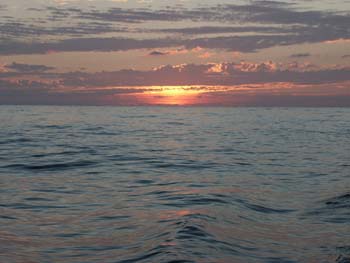 We arrived at our Ixtapa anchorage to watch the sun
rise. We could see the empty palapas on the beach waiting for the people to
arrive. We took Zig ashore on the kayak where he chased crabs until they
finally gave up and hid in the cracks in the rocks until we left. We swam and
rested under the shade of the palapas. We ate fresh grilled fish and drank
beers. Larry finally relaxed in his lounge chair and snored out loud much to
the surprise and laughter of the native Mexicans. It was his first
real rest for months. The water was refreshing and clean.
We arrived at our Ixtapa anchorage to watch the sun
rise. We could see the empty palapas on the beach waiting for the people to
arrive. We took Zig ashore on the kayak where he chased crabs until they
finally gave up and hid in the cracks in the rocks until we left. We swam and
rested under the shade of the palapas. We ate fresh grilled fish and drank
beers. Larry finally relaxed in his lounge chair and snored out loud much to
the surprise and laughter of the native Mexicans. It was his first
real rest for months. The water was refreshing and clean.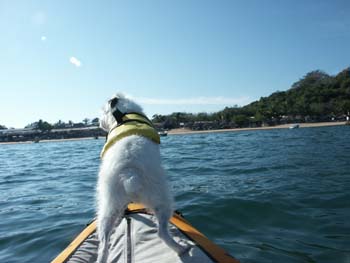
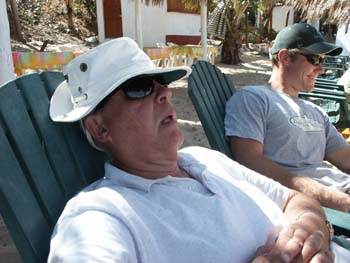
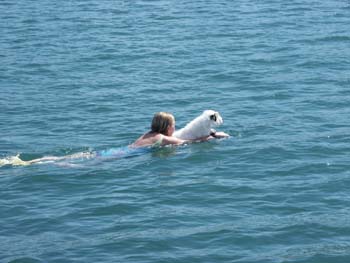
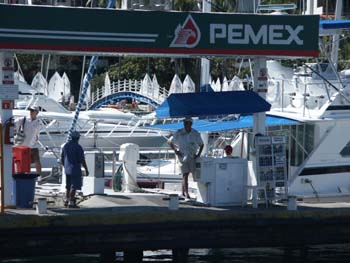 But
as the Mexican way is, our 8:00 AM appointment was pushed to noon while the
Mexican juggle for position at the fuel dock began. We didn’t realize it but
arrived on the first day of a four-day sailing regatta at the Acapulco Yacht
Club. The place was bustling with sailors and important people. A Navy band
was playing their nation anthem on the dock and it was non-stop partying for our
entire visit. The yacht club was a beautiful open air building with swimming
pool and lawns and a nice restaurant and bar. Lovely.
But
as the Mexican way is, our 8:00 AM appointment was pushed to noon while the
Mexican juggle for position at the fuel dock began. We didn’t realize it but
arrived on the first day of a four-day sailing regatta at the Acapulco Yacht
Club. The place was bustling with sailors and important people. A Navy band
was playing their nation anthem on the dock and it was non-stop partying for our
entire visit. The yacht club was a beautiful open air building with swimming
pool and lawns and a nice restaurant and bar. Lovely. 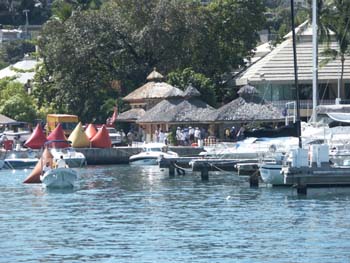
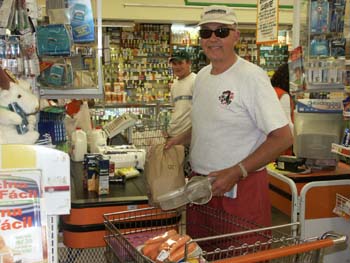
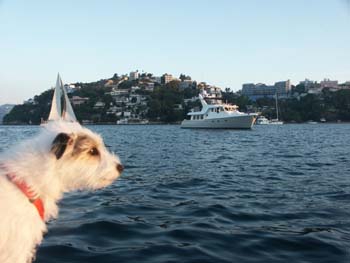 The marina is the first part that is
finished. Huatulco is the last stop before crossing the notorious Golfo de
Tehuantepec. As many of you boaters know this is a stretch that is exposed to
vicious winds that come from the Gulf of Mexico across 100 miles of land into
the Pacific. It’s the only open area where the Sierra Madre Mountains have a
gap that allows this condition. It’s like a funnel where the winds build into a
force to be reckoned with as the gush out onto the Pacific.
The marina is the first part that is
finished. Huatulco is the last stop before crossing the notorious Golfo de
Tehuantepec. As many of you boaters know this is a stretch that is exposed to
vicious winds that come from the Gulf of Mexico across 100 miles of land into
the Pacific. It’s the only open area where the Sierra Madre Mountains have a
gap that allows this condition. It’s like a funnel where the winds build into a
force to be reckoned with as the gush out onto the Pacific.
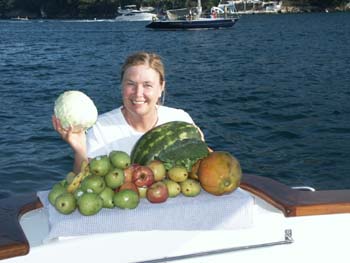
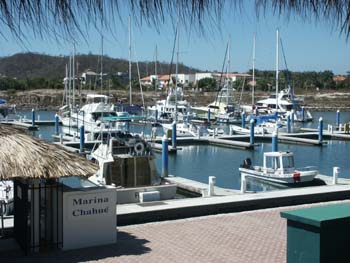
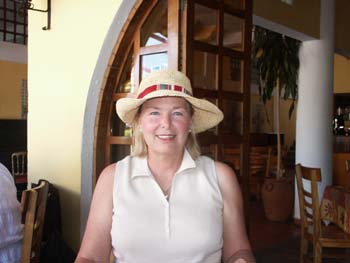
 Capt Rains and our weather service (contact Walter) think
in two days from now the existing gale conditions will lay flat for a awhile to
give us a window to go and then the gales will be back again. Rains says this
is the worst time of the year to make this crossing. He’s been ranting about
the horrific conditions in the Caribbean for a few days now and I guess they
have made their way here. We don’t experience any of it at the dock but the 20
miles or more approaching Huatulco gave us a brief taste of what might be out
there.
Capt Rains and our weather service (contact Walter) think
in two days from now the existing gale conditions will lay flat for a awhile to
give us a window to go and then the gales will be back again. Rains says this
is the worst time of the year to make this crossing. He’s been ranting about
the horrific conditions in the Caribbean for a few days now and I guess they
have made their way here. We don’t experience any of it at the dock but the 20
miles or more approaching Huatulco gave us a brief taste of what might be out
there.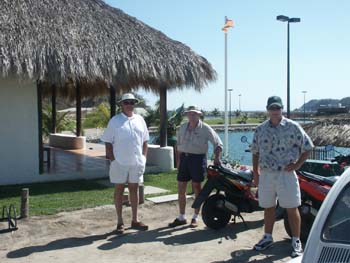
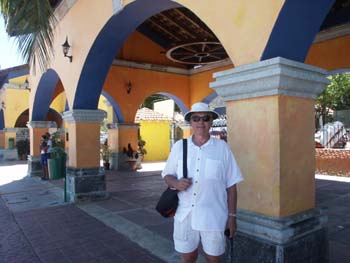
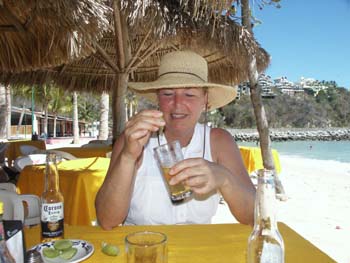 We enjoyed the area for our brief visit and sampled some of
their famous Pollo Mole and homemade Oaxacan cheese. Larry had tamales wrapped
in banana leaves that brought on a sweat that almost included steam coming out
his ears. We stocked up at the local Mercado and bartered for fruits and
vegetables. The locals seem to enjoy winning the barter and it’s an excuse to
chitchat with my feeble Spanish. We bought luscious papaya, chayote, jicama,
and Jamaica which are dried red flower petals to make a cooling drink like ice
tea. We bought freshly made hot tortillas, locally harvested coffee and
homemade cheese which tastes something like feta. It was a colorful experience.
We enjoyed the area for our brief visit and sampled some of
their famous Pollo Mole and homemade Oaxacan cheese. Larry had tamales wrapped
in banana leaves that brought on a sweat that almost included steam coming out
his ears. We stocked up at the local Mercado and bartered for fruits and
vegetables. The locals seem to enjoy winning the barter and it’s an excuse to
chitchat with my feeble Spanish. We bought luscious papaya, chayote, jicama,
and Jamaica which are dried red flower petals to make a cooling drink like ice
tea. We bought freshly made hot tortillas, locally harvested coffee and
homemade cheese which tastes something like feta. It was a colorful experience.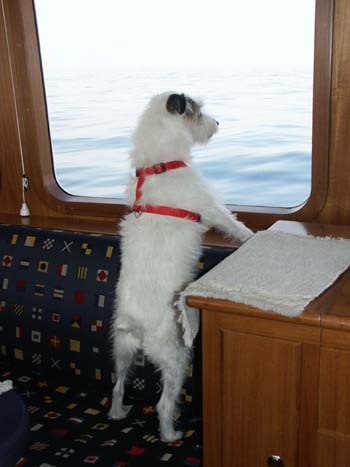 We could here them chit chat
amongst themselves nervously on the radio checking conditions with each other.
One boat that had an early start because he finished his “cha cha” a day before
was reporting conditions of 40 knot winds ahead and some swells that were
giving them a “yahoo” ride. Some of these people must be crazy that come down
here doing this. I guess we fit into that category.
We could here them chit chat
amongst themselves nervously on the radio checking conditions with each other.
One boat that had an early start because he finished his “cha cha” a day before
was reporting conditions of 40 knot winds ahead and some swells that were
giving them a “yahoo” ride. Some of these people must be crazy that come down
here doing this. I guess we fit into that category.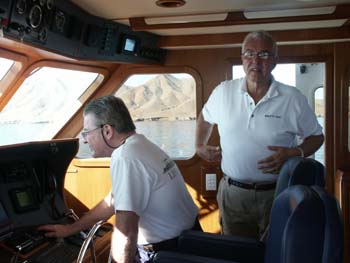
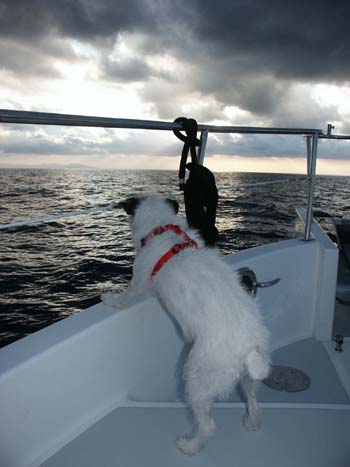
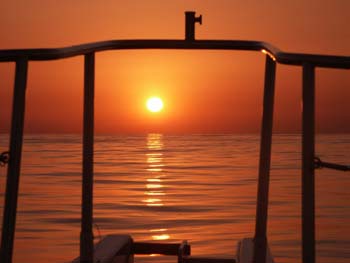 As I write this, it’s the next day and seas are not totally
settled but I’m able to sit on the back deck and write this on the laptop. It’s
comfortable but we are one big salt chuck. There’s a crust of salt on
everything including Ziggy. Rains says we are in for some more rough stuff
later this evening so I have pre cooked the dinner to have it ready. Scott has
washed all the windows so we can see. We are rested and ready for the next go
of it.
As I write this, it’s the next day and seas are not totally
settled but I’m able to sit on the back deck and write this on the laptop. It’s
comfortable but we are one big salt chuck. There’s a crust of salt on
everything including Ziggy. Rains says we are in for some more rough stuff
later this evening so I have pre cooked the dinner to have it ready. Scott has
washed all the windows so we can see. We are rested and ready for the next go
of it. 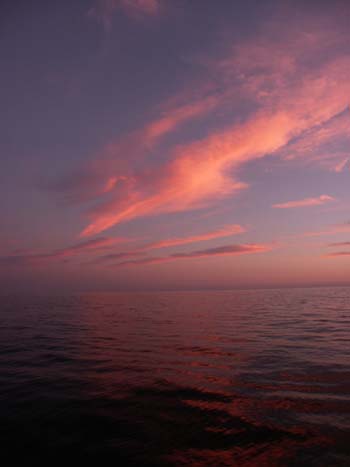 We become in
tune with the wind and motion of the sea and the passing of a sea turtle is an
event that all enjoy and tell each other about. We had a couple “booby birds”
that were trying to hitch a ride the other night but Ziggy will have nothing to
do with that. He chases them all around the walkway barking at the top of his
lungs. He seems to love the sea and loves to peep out threw viewpoints that
he’s found to see what’s going on. His favorite spot is on the bow in calm seas
where he looks like the true mascot that he is.
We become in
tune with the wind and motion of the sea and the passing of a sea turtle is an
event that all enjoy and tell each other about. We had a couple “booby birds”
that were trying to hitch a ride the other night but Ziggy will have nothing to
do with that. He chases them all around the walkway barking at the top of his
lungs. He seems to love the sea and loves to peep out threw viewpoints that
he’s found to see what’s going on. His favorite spot is on the bow in calm seas
where he looks like the true mascot that he is.